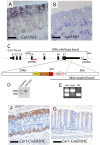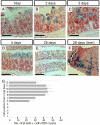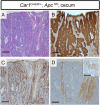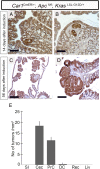Generation of an inducible colon-specific Cre enzyme mouse line for colon cancer research
- PMID: 27708166
- PMCID: PMC5081651
- DOI: 10.1073/pnas.1614057113
Generation of an inducible colon-specific Cre enzyme mouse line for colon cancer research
Abstract
Current mouse models for colorectal cancer often differ significantly from human colon cancer, being largely restricted to the small intestine. Here, we aim to develop a colon-specific inducible mouse model that can faithfully recapitulate human colon cancer initiation and progression. Carbonic anhydrase I (Car1) is a gene expressed uniquely in colonic epithelial cells. We generated a colon-specific inducible Car1CreER knock-in (KI) mouse with broad Cre activity in epithelial cells of the proximal colon and cecum. Deletion of the tumor suppressor gene Apc using the Car1CreER KI caused tumor formation in the cecum but did not yield adenomas in the proximal colon. Mutation of both Apc and Kras yielded microadenomas in both the cecum and the proximal colon, which progressed to macroadenomas with significant morbidity. Aggressive carcinomas with some invasion into lymph nodes developed upon combined induction of oncogenic mutations of Apc, Kras, p53, and Smad4 Importantly, no adenomas were observed in the small intestine. Additionally, we observed tumors from differentiated Car1-expressing cells with Apc/Kras mutations, suggesting that a top-down model of intestinal tumorigenesis can occur with multiple mutations. Our results establish the Car1CreER KI as a valuable mouse model to study colon-specific tumorigenesis and metastasis as well as cancer-cell-of-origin questions.
Keywords: Car1; colorectal cancer; differentiated epithelial cells; gastrointestinal tract; mouse model.
Conflict of interest statement
The authors declare no conflict of interest.
Figures













Similar articles
-
Mouse model of proximal colon-specific tumorigenesis driven by microsatellite instability-induced Cre-mediated inactivation of Apc and activation of Kras.J Gastroenterol. 2016 May;51(5):447-57. doi: 10.1007/s00535-015-1121-9. Epub 2015 Sep 11. J Gastroenterol. 2016. PMID: 26361962
-
Stromal Indian hedgehog signaling is required for intestinal adenoma formation in mice.Gastroenterology. 2015 Jan;148(1):170-180.e6. doi: 10.1053/j.gastro.2014.10.006. Epub 2014 Oct 13. Gastroenterology. 2015. PMID: 25307863
-
Mouse model of colonic adenoma-carcinoma progression based on somatic Apc inactivation.Cancer Res. 2007 Oct 15;67(20):9721-30. doi: 10.1158/0008-5472.CAN-07-2735. Cancer Res. 2007. PMID: 17942902
-
Mutant p53 in colon cancer.J Mol Cell Biol. 2019 Apr 1;11(4):267-276. doi: 10.1093/jmcb/mjy075. J Mol Cell Biol. 2019. PMID: 30496442 Free PMC article. Review.
-
Multistep carcinogenesis of the colon in Apc(Min/+) mouse.Cancer Sci. 2007 Jan;98(1):6-10. doi: 10.1111/j.1349-7006.2006.00348.x. Cancer Sci. 2007. PMID: 17052257 Free PMC article. Review.
Cited by
-
Reconstructing the tumor architecture into organoids.Adv Drug Deliv Rev. 2021 Sep;176:113839. doi: 10.1016/j.addr.2021.113839. Epub 2021 Jun 19. Adv Drug Deliv Rev. 2021. PMID: 34153370 Free PMC article. Review.
-
The Transcriptomic Landscape of Mismatch Repair-Deficient Intestinal Stem Cells.Cancer Res. 2021 May 15;81(10):2760-2773. doi: 10.1158/0008-5472.CAN-20-2896. Epub 2021 Mar 18. Cancer Res. 2021. PMID: 34003775 Free PMC article.
-
Tissue-location-specific transcription programs drive tumor dependencies in colon cancer.Nat Commun. 2024 Feb 15;15(1):1384. doi: 10.1038/s41467-024-45605-4. Nat Commun. 2024. PMID: 38360902 Free PMC article.
-
The Car1 Knockout Mice Exhibit Antidepressant-like Behaviors Accompanied with Gut Microbiota Disturbance.Cell Biochem Biophys. 2025 Mar;83(1):777-782. doi: 10.1007/s12013-024-01509-0. Epub 2024 Sep 28. Cell Biochem Biophys. 2025. PMID: 39340592
-
Defining key concepts of intestinal and epithelial cancer biology through the use of mouse models.Carcinogenesis. 2017 Oct 1;38(10):953-965. doi: 10.1093/carcin/bgx080. Carcinogenesis. 2017. PMID: 28981588 Free PMC article. Review.
References
Publication types
MeSH terms
Substances
LinkOut - more resources
Full Text Sources
Other Literature Sources
Molecular Biology Databases
Research Materials
Miscellaneous

